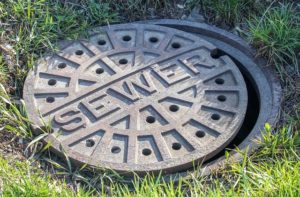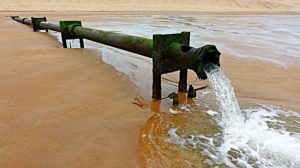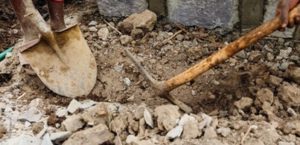
We Brits love our food fast and fried – with England alone being fit to burst with nearly 60,000 fast-food joints. As we gorge on endless pizzas, fish and chips and Chinese takeaways, the businesses which we pay to produce our deep-fried mains, snacks and sides are churning out thousands upon thousands of tonnes of fat, oil and grease (FOG) waste.
And that’s not to mention Britain’s 27 million households, tens of thousands of restaurants, pubs, and canteens (to be found in offices, schools, hospitals and prisons up and down the country) – who all contribute their fair share of FOG.
Where does it all go? The answer to that question is one which many of us would rather ignore.
Often, those difficult-to-dispose-of FOGs end up being sent straight down our drains and into our sewers, where they contribute to one of the biggest problems which we face today: fatbergs.
But what exactly are these monsters lurking under our streets?
What is a Fatberg?
Fatbergs are a relatively recent phenomenon. They got their name in 2013 when the first fatberg was found in a sewer in Kingston Upon Thames in London. They first found fame in 2017, when a 250 metre, 130 tonne mass of fat was discovered in a sewer in Whitechapel and quickly hit the headlines.

Since then, many more have been discovered and studied, leaving us with some early ideas of how they form and what they are made of.
We have discovered that our ageing Victorian sewers are particularly prone to fatberg formation. The walls of our sewers are uneven, rugged, with plenty of nooks and crannies which, it turns out, FOG waste loves to cling to as it cools.
Once our old cooking oils and used fats find one of these cracks, they bind to it and to each other, swirling by the walls until they catch more and more FOG. Along with fats, oils and grease, these swelling masses of waste catch anything else which happens to be flowing past – including wet wipes, condoms, tampons and, dependent on the habits of the people who live in the streets above, dentures and, even possibly syringes.
The waste snowballs, building up and growing denser – until the coagulated clog becomes as hard as concrete. Gradually, the sewer becomes blocked – with the usual flow of raw sewage slowing and eventually coming to a stop.
What Happens Next?
- Fatbergs wreck the Environment
Our sewers can only cope with so much. Sometimes they overflow. Sewers overflow for one of two reasons: either the sewers have filled up with an excess of water – perhaps due to a heavy storm – or something has happened which means that the sewer can no longer handle the usual volume of wastewater.
For fatbergs, the second reason is the most relevant. Fatbergs take up space in our sewers, making them less effective and making it more likely that they will overflow, sending raw sewage straight into our waterways.
These sewage overflows are bad for our streams and rivers for two further reasons. The first: raw sewage is often pretty toxic, containing chemicals and dangerous strains of bacteria which can kill many of the plant and animal species which call our waterways home. The second: raw sewage contains a huge amount of nitrates and other nutrients. This may sound good – it is not. An excess of nutrients in a body of water can cause excessive growth of certain plants, such as algae, which can make life difficult for the other plants and animals which live alongside them.

- Fatbergs Threaten Your Health
While some fatbergs are much more dangerous than others, picking up a chunk of any berg with your bare hands is never a good idea.
A sizeable number pose physical risks – with used needles being found in many of those bergs which have been pulled out of sewers in our cities. Many more are likely to contain that mix of toxic cleaning chemicals and dangerous strains of bacteria which have been seen above to threaten the lives of our flora and fauna.
But even if you aren’t planning to touch a berg any time soon, you may still come into contact with them indirectly. These lumps of fat are a food source which is loved by rats – whose populations often boom in areas of our sewers where a fatberg is forming. These pests, moving freely between our streets and our sewers, may even traipse traces of faecal-matter soaked FOG into our homes.
Fatbergs are a menace. So:
How Do We Remove Them?
Water company workers are currently responsible for finding fatbergs in our sewers.
But they have their work cut out. While fatbergs have been known to smell like a mixture of rotting meat, searching for them is often like looking for a needle in a haystack. With tens of thousands of miles of sewers to check manually, it’s time-consuming work.

When a fatberg is finally found, crews get to work using high powered hoses alongside old fashioned chisels and pickaxes to work away at the bergs, breaking chunks off at a time and sending them off to sewage treatment plants.
The price tag on these removal operations can be huge. The average fatberg calls for weeks of work and a budget of around £100,000 – with the worst cases taking far longer and costing far more. To remove the 2017 Whitechapel berg, for instance, Thames Water had to spend £2million over 2 months.
While some programmes, such as that being run jointly by Thames Water and Argent Energy, aiming to turn fatbergs into biofuels have helped to offset these costs, the fatberg problem is still an expensive issue to be reckoned with.
As those costs are increasingly being passed on to food businesses deemed responsible for nearby bergs in the form of fines, it’s a good idea to get on the right side of the fight.
Do Your Bit To Prevent The Bergs
Invest in and professionally install a good quality grease trap and you’ll have laid the foundations for an excellent grease management plan. Take care of your trap properly and your trap will keep your FOG output in check by intercepting your wastewater and allowing the fats, oils and grease which have slipped down your drains some time to cool, solidify and stay out of our sewers.
Get your stainless steel grease trap today and do your part to fight the fatbergs.

Leave a Comment
Your email address will not be published. Required fields are marked *